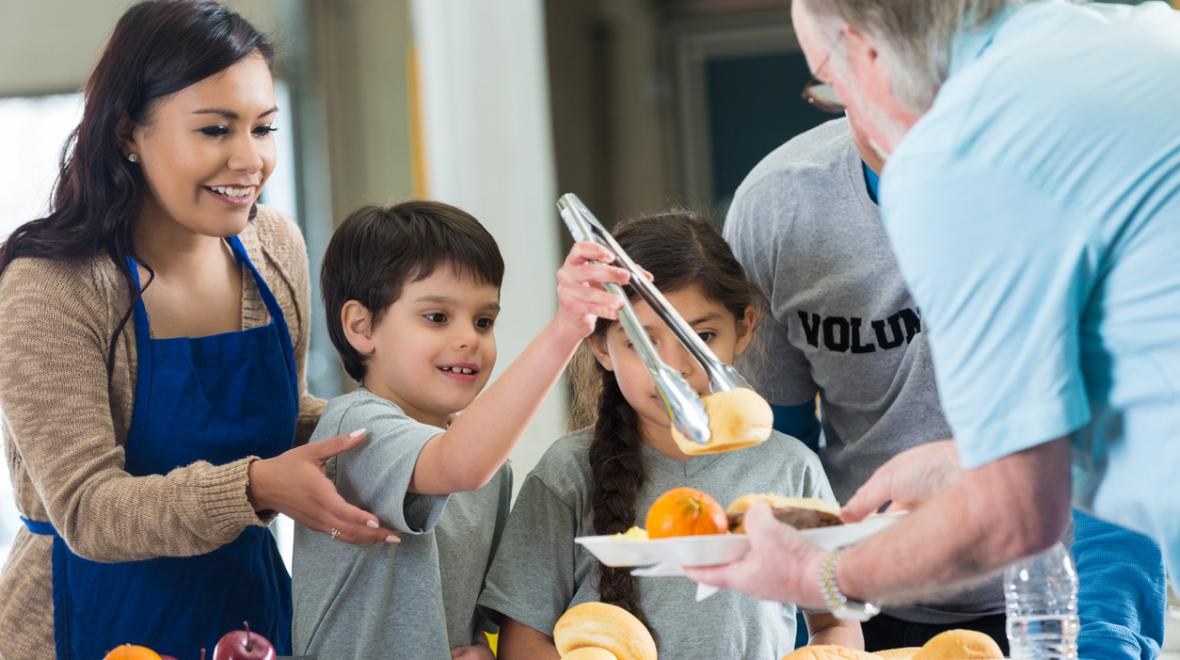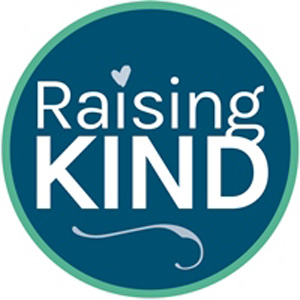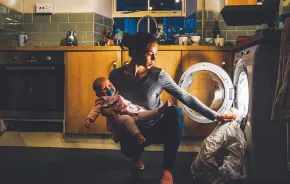
Every holiday season, we’re reminded of the importance of volunteering, but we don’t need seasonal reminders to realize people are in need. Take our area’s biggest city. You can’t go a block in Seattle without seeing someone without a home (a reality reflected in the startlingly statistic that the number of people living on the streets in King County has jumped 21 percent since last year).
While we can — and should — talk with our children about what that statistic means, a whole new level of learning happens when families volunteer together to help those in need.
Christine Craig of North Seattle recalls her 6-year-old daughter’s reaction to volunteering at Wellspring Family Services. “She said, ‘I thought we were helping homeless people. They look just like us,’” says Craig.
Suddenly, Craig’s kids knew homelessness didn’t fit inside a stereotype. “To realize a homeless person could be anyone and not just a person they saw panhandling on the corner drove home the lesson that you need to be kind to everyone at school, because you can’t tell what’s going on in their lives,” says Craig, who started volunteering with her four children when they were preschoolers.
Creating such learning experiences is just one of many reasons family volunteering is beneficial, but how to do it? Here are the whys and hows of volunteering together — whether it’s addressing our area’s critical problem with housing or supporting our community in others ways this holiday season.
 Why it’s worth it
Why it’s worth it
While our instincts often tell us to shield our kids, volunteering helps kids deal with the world and its problems. After volunteering to help the homeless, one of Craig’s kids became worried that their family would lose their home. But it wasn’t the volunteering that caused that concern; rather, volunteering allowed that concern to surface, says parenting expert Sarina Behar Natkin. Children are thinking thoughts like this all the time, but don’t know it’s okay to say them aloud until they’re presented with opportunities to talk, she says.
Volunteering creates such an opportunity, says Rachel Murray, volunteer engagement manager at United Way of King County.
“[It allows] dialogue with family members about the community they live in, the issues the community faces and the great work that is going on to work towards solving those issues,” Murray says. It’s also a tangible way to build a sense of compassion and empathy for those less fortunate than ourselves, she adds.
Doing good is also a huge boost for young kids struggling with behavior issues. “The added responsibility and the act of volunteering give a child the sense that ‘I matter,’” says Natkin. “When we feel connected to something, we’re more cooperative.”
Volunteering as a unit also strengthens family bonds. “Getting outside of ourselves and our individual problems and doing this as a family builds cooperation, collaboration and connection,” says Natkin. Her own family’s best family meeting happened after volunteering together, she notes.
How to make it happen
If you want a recipe for disaster, go from zero volunteering to four hours every Saturday without getting your kids’ buy-in and not prepping them beforehand.
“I’ve had parents bring their kids in, saying they forgot to tell them what they’re doing today. That is a hard sell,” says Nichelle Hilton, community resource coordinator at YWCA Seattle-King-Snohomish.
The first tip for success: Start small. Perhaps build a care kit at home. This small care package often includes practical items that will be of use to someone without a regular home. Online, you’ll find plenty of ideas about what to include in the package; socks, snacks, and hotel-size shampoos and soaps are popular items. Families can also ask nonprofits what the organizations would like in a care kit.
While you can make a care kit at home to donate to a local nonprofit, organizations, including United Way, offer one-time events where families assemble care kits while organizers discuss social justice issues. (Many local nonprofits are also open to discussing specific ideas for individual families, too; for the YWCA, Hilton welcomes emails at nhilton@ywcaworks.org.)
If your family wants to volunteer outside of the home, find family-friendly opportunities that fit your child’s age. Two websites that will help are GenerationOn, a resource that includes project ideas and reflection guides, and Doing Good Together, a national nonprofit whose goal is to make volunteering and service easy for families.
Locally, families can find a variety of kid-specific options, such as serving meals at Compass Housing Alliance and Operation Sack Lunch or volunteering with the Jewish Family Service of Seattle. During the holiday season, several King County nonprofits, including YWCA, Wellspring, Bellevue LifeSpring, Hopelink and Treehouse, accept gifts for families in need through the community-wide Adopt-a-Family program.
When choosing a volunteering opportunity, remember that kids often prefer experiences that show direct impact, Murray says. That was the case for Seattle mom Jen Bergman. Her 7-year-old son, Jake, loves handing out food at the Georgetown Food Bank because, he tells Bergman, “everyone likes what I give them, and it makes them happy.”
For Craig, as her children have grown, she’s been pleasantly surprised by the meaning they’ve found through volunteering. Without any prompting, her 15-year-old began volunteering with the Pike Place Market Foundation’s Food Access Program this summer, and her 17-year-old regularly volunteers with both a suicide prevention program and King County’s Youth Justice restorative justice program.
Starting to volunteer at a young age helps positively shape a child’s worldview, notes Bergman. “[It changes] who they interact with and how they interact,” she says. “It makes a difference in how they see the world.”
And that’s a lesson that will last long past the holidays.
This story appears in ParentMap's November 2017 print edition. Subscribe today!











